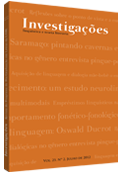Ironia imagética em Saramago: pintando cavernas e jangadas com palavras
Abstract
Este estudo teve como objetivo caracterizar e definir a ironia, investigando suas diferentes estratégias de formulação. Nosso corpus compõe-se dos romances A Caverna e A Jangada de Pedra, ambos de José Saramago. Foram utilizados não só estudos específicos sobre a ironia, mas também pressupostos e conceitos do Sociointeracionismo Americano. Concluiu-se que o fenômeno irônico pode revelar-se sob três formas de construção: (1) de forma predominantemente verbal; (2) por meio da multimodalidade, em que fotos, desenhos e cores diferenciadas unem-se a recursos linguísticos para a produção de sentido; (3) por meio exclusivamente verbal, porém gerando uma imagem que, uma vez concluída, dispensa a linguagem utilizada em sua formação e inscreve-se como desenho crítico na mente dos leitores. Neste artigo, nos deteremos no estudo desse terceiro tipo de ironia identificado, aqui chamado de ironia imagética.
Palavras-chave: tipos de ironia; ironia imagética; romances.
Downloads
How to Cite
Issue
Section
License
Copyright (c) 1969 Kazue Saito Monteiro de Barros, Liliane Felix Valença Cintra

This work is licensed under a Creative Commons Attribution 4.0 International License.
Authors who publish with Revista Investigações agree to the following terms:
Authors retain copyright and grant the journal right of first publication with the work simultaneously licensed under the Creative Commons Attribution 4.0 International (CC BY 4.0) license that allows others to share the work with an acknowledgement of the work's authorship and initial publication in this journal.
Authors are able to enter into separate, additional contractual arrangements for the non-exclusive distribution of the journal's published version of the work (e.g., post it to an institutional repository or publish it in a book), with an acknowledgement of its initial publication in this journal.
You are free to:
Share — copy and redistribute the material in any medium or format for any purpose, even commercially.
Adapt — remix, transform, and build upon the material for any purpose, even commercially.
The licensor cannot revoke these freedoms as long as you follow the license terms.
Under the following terms:
Attribution — You must give appropriate credit , provide a link to the license, and indicate if changes were made . You may do so in any reasonable manner, but not in any way that suggests the licensor endorses you or your use.
No additional restrictions — You may not apply legal terms or technological measures that legally restrict others from doing anything the license permits.

